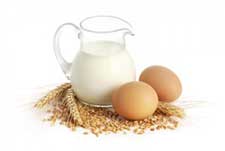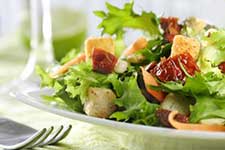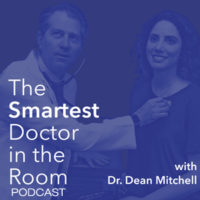Candida Diet and Program Update: Less Restrictions, More Options

[updated August 2019]
If you are reading this blog, I gather you are familiar with the condition Candida hypersensitivity. You may be suffering from any of the assorted symptoms that Candida can cause: bloating, constipation, gastric reflux, skin rashes, vaginal yeast infections, brain fog, and fatigue.
I get so many questions from well-educated patients about the Candida diet. The first thing you will read on most health websites is that the Candida diet is what you need to cure your problem. However, while some patients are willing to try any diet to feel better it does seem unrealistic to stay on this very restrictive diet forever – and I’m here to tell you that you don’t have to. I’m not just writing this to give you the easy way out – I’m going by what a respected medical researcher and fellow Candida expert, Marjorie Crandell, Ph.D. have discussed with me.
Myth: Candida Can Be Cured by Diet Alone
You can’t cure Candida reactions with diet alone. True, following some of the dietary suggestions that will be made will strive to prevent further inflammation in the body, but it won’t reverse the immune reaction already occurring. If there is a yeast overgrowth in the body whether it is in the stomach, skin, genitals or brain it has to be reduced with antifungal medication. The newer antifungal medications are quite good at eradicating the yeast in body tissue, but in many cases, the treatment is not given long enough to do its job. Many doctors and patients are concerned about the effects on the liver from these antifungal medicines; but, in truth, most healthy patients can tolerate reasonable doses quite well without changes in liver function tests.
Fact: Vitamin Fortification Builds Immunity
We all know that vitamin deficiency can make us vulnerable to infections and allergies. But we take for granted that bolstering up the immune system with vitamins can keep infections and inflammation in check. Oral vitamins would normally be fine, but in many patients with Candida hypersensitivity, the gut is not functioning at an optimal level. We have found in our practice at Mitchell Medical Group that giving injectable vitamins gets the high tissue levels of key vitamins that keep the immune system strong and beat down Candida overgrowth.
Myth: No Carbs, Low Carbs Only Option
I like Dr. Crandell’s quote: “you cannot cure yeast infections by starving yourself!” I agree. And we both agree there are good carbohydrates and bad carbohydrates. The good ones come from nature: any vegetable you enjoy should be fine ( we only restrict corn, mushrooms, and potatoes); we also recommend restricting fermented vegetables as they may contain yeast and inflame the body.
Grains can be kept in the diet, but we prefer that they have fiber; this is good for the colon to help make the good bacteria your lower intestine needs for vitamin production. Oatmeal, quinoa and even some rice are acceptable. Lentils and peas are also mainly carbohydrates, but they are a good source of fiber.
Fact: Cleanse the Liver
I tell patients that before we plan to rebalance their immune system to eradicate the Candida with antifungal medication it is wise to cleanse the liver. This is accomplished by using injectable glutathione. Glutathione is one of our body’s most potent anti-oxidants and enables the liver to better detoxify the toxins released by Candida.
Myth: No Dairy

Dairy is made from milk products whether it’s from a cow or goat. All types contain lactose, which is a type of sugar; however, dairy products are made from bacteria, not yeast or mold. So, some Candida patients will tolerate dairy and others may not. You can try cheddar cheese, swiss and cottage cheese- and even yogurt. If you are prone to bloating or constipation you may want to avoid dairy.
Fact: You Can Add Vinegar or Lemon to Your Salad Dressing

Distilled white vinegar is the safest as is freshly squeezed lemon juice- this is what I enjoy with some Virgin Olive oil on my salads. Be aware though of Apple Cider Vinegar; this is typically thought of like a very healthy vinegar for digestive health. However, you can be allergic to apple cider vinegar- and it doesn’t kill yeast as some think.
Myth: No Alcohol Forever
I do strongly request that patients avoid alcohol while going through the liver cleanse and on antifungals; it also makes sense to give the gut and liver a chance to heal. But with good success and a strong treatment plan, it is possible to imbibe with distilled liquors such as bourbon, rum, vodka or gin within 4- 6 months.
Bottom Line:
Eating a Healthy Diet Will Make You Feel Better!
The truth of the matter is that when my patients stop eating processed foods and start eating more “live foods” with nutrients and enzymes they begin to feel better.
Curb Sugar Cravings
Did you know that it’s possible to experience sugar withdrawal symptoms? When you suddenly eliminate added and simple sugars from your diet, you might experience intense cravings, fatigue, anxiety, and a low mood. This is because sugar stimulates the reward center of the brain. Manage sugar cravings by eliminating sweets gradually. Start by refraining from putting sugar in your coffee or honey in your tea. Then, avoid all added sugars altogether before focusing on eliminating other sources of simple sugars like white rice.
Avoiding the “white devils”: sugar, wheat flour, and white rice will stabilize your blood sugar and decrease inflammation in your body.
Become a Meal Planner
Processed convenience meals are one reason why yeast overgrowth is so common. If you have a packed schedule, grabbing takeout is certainly tempting, but this won’t be possible on the candida diet. To make the transition easier, become a meal planner. Every weekend, design a dinner plan for the week that only includes whole foods. Once you’ve gotten accustomed to planning your dinners, start planning your other meals and snacks too. Your candida doctor can help you with your new meal plan.
For great suggestions on how to eat super healthy and enjoy the Candida diet please go to cara and candida on Instagram and see how enjoyable finding healthy foods can be.
Related Articles

- What is Candida Brain Fog and How is it Treated?
- The Best Probiotic for Your Candida
- How to Test for Candida
- Interstitial Cystitis and Candida Overgrowth
– Dr. Dean Mitchell, M.D.
Mitchell Medical Group, NYC
About the Author – Dr. Dean Mitchell, M.D.
Dr. Dean Mitchell, M.D. is a Board Certified Allergist and Immunologist based out of NYC. He graduated from the Sackler School of Medicine and completed training at the Robert Cooke Allergy Institute in New York City. He is also a Clinical Assistant Professor at Touro College of Osteopathic Medicine, a fellow of the American Academy of Allergy, Asthma, and Immunology, and the author of Dr. Dean Mitchell’s Allergy and Asthma Solution: The Ultimate Program for Reversing Your Symptoms One Drop at a Time. Dr. Dean Mitchell, M.D. has also been featured in The New York Times, The Huffington Post, Fitness Magazine, Dr. Oz and News NY 1. Dr. Mitchell also hosts the podcast The Smartest Doctor in the Room – a combination of a lively, personal and in-depth interview with top healthcare specialists.
References:
Reinagel, Monica. The Candida Diet: Separating Fact from Fiction. Scientific American, August 15, 2018. https://www.scientificamerican.com/article/the-candida-diet-separating-fact-from-fiction/
Schroeder, Michael O. Does the Candida Diet Work – and Is It Safe? US News, July 23, 2019. https://health.usnews.com/wellness/food/articles/candida-cleanse-diet-does-this-work-and-is-it-safe

